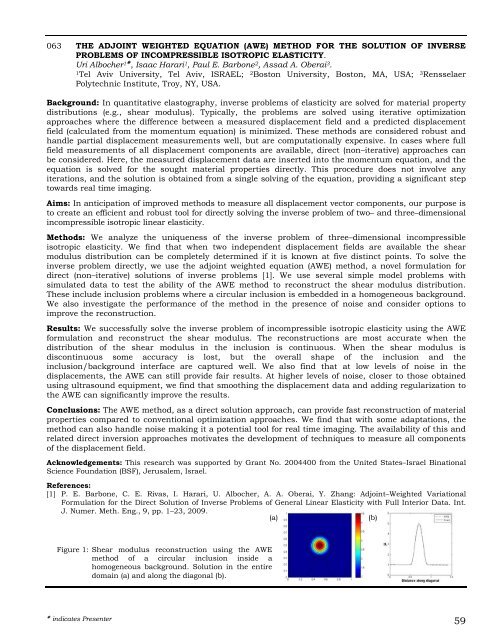2012 Proceedings - International Tissue Elasticity Conference
2012 Proceedings - International Tissue Elasticity Conference
2012 Proceedings - International Tissue Elasticity Conference
You also want an ePaper? Increase the reach of your titles
YUMPU automatically turns print PDFs into web optimized ePapers that Google loves.
063 THE ADJOINT WEIGHTED EQUATION (AWE) METHOD FOR THE SOLUTION OF INVERSE<br />
PROBLEMS OF INCOMPRESSIBLE ISOTROPIC ELASTICITY.<br />
Uri Albocher 1 , Isaac Harari 1 , Paul E. Barbone 2 , Assad A. Oberai 3 .<br />
1 Tel Aviv University, Tel Aviv, ISRAEL; 2 Boston University, Boston, MA, USA; 3 Rensselaer<br />
Polytechnic Institute, Troy, NY, USA.<br />
Background: In quantitative elastography, inverse problems of elasticity are solved for material property<br />
distributions (e.g., shear modulus). Typically, the problems are solved using iterative optimization<br />
approaches where the difference between a measured displacement field and a predicted displacement<br />
field (calculated from the momentum equation) is minimized. These methods are considered robust and<br />
handle partial displacement measurements well, but are computationally expensive. In cases where full<br />
field measurements of all displacement components are available, direct (non–iterative) approaches can<br />
be considered. Here, the measured displacement data are inserted into the momentum equation, and the<br />
equation is solved for the sought material properties directly. This procedure does not involve any<br />
iterations, and the solution is obtained from a single solving of the equation, providing a significant step<br />
towards real time imaging.<br />
Aims: In anticipation of improved methods to measure all displacement vector components, our purpose is<br />
to create an efficient and robust tool for directly solving the inverse problem of two– and three–dimensional<br />
incompressible isotropic linear elasticity.<br />
Methods: We analyze the uniqueness of the inverse problem of three–dimensional incompressible<br />
isotropic elasticity. We find that when two independent displacement fields are available the shear<br />
modulus distribution can be completely determined if it is known at five distinct points. To solve the<br />
inverse problem directly, we use the adjoint weighted equation (AWE) method, a novel formulation for<br />
direct (non–iterative) solutions of inverse problems [1]. We use several simple model problems with<br />
simulated data to test the ability of the AWE method to reconstruct the shear modulus distribution.<br />
These include inclusion problems where a circular inclusion is embedded in a homogeneous background.<br />
We also investigate the performance of the method in the presence of noise and consider options to<br />
improve the reconstruction.<br />
Results: We successfully solve the inverse problem of incompressible isotropic elasticity using the AWE<br />
formulation and reconstruct the shear modulus. The reconstructions are most accurate when the<br />
distribution of the shear modulus in the inclusion is continuous. When the shear modulus is<br />
discontinuous some accuracy is lost, but the overall shape of the inclusion and the<br />
inclusion/background interface are captured well. We also find that at low levels of noise in the<br />
displacements, the AWE can still provide fair results. At higher levels of noise, closer to those obtained<br />
using ultrasound equipment, we find that smoothing the displacement data and adding regularization to<br />
the AWE can significantly improve the results.<br />
Conclusions: The AWE method, as a direct solution approach, can provide fast reconstruction of material<br />
properties compared to conventional optimization approaches. We find that with some adaptations, the<br />
method can also handle noise making it a potential tool for real time imaging. The availability of this and<br />
related direct inversion approaches motivates the development of techniques to measure all components<br />
of the displacement field.<br />
Acknowledgements: This research was supported by Grant No. 2004400 from the United States–Israel Binational<br />
Science Foundation (BSF), Jerusalem, Israel.<br />
References:<br />
[1] P. E. Barbone, C. E. Rivas, I. Harari, U. Albocher, A. A. Oberai, Y. Zhang: Adjoint–Weighted Variational<br />
Formulation for the Direct Solution of Inverse Problems of General Linear <strong>Elasticity</strong> with Full Interior Data. Int.<br />
J. Numer. Meth. Eng., 9, pp. 1–23, 2009.<br />
(a) (b)<br />
Figure 1: Shear modulus reconstruction using the AWE<br />
method of a circular inclusion inside a<br />
homogeneous background. Solution in the entire<br />
domain (a) and along the diagonal (b).<br />
indicates Presenter 59









